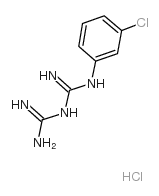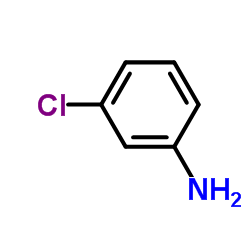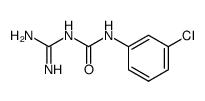1-(3-chlorophenyl)biguanide hydrochloride

1-(3-chlorophenyl)biguanide hydrochloride structure
|
Common Name | 1-(3-chlorophenyl)biguanide hydrochloride | ||
|---|---|---|---|---|
| CAS Number | 2113-05-5 | Molecular Weight | 248.11 | |
| Density | 1.49g/cm3 | Boiling Point | 434.1ºC at 760mmHg | |
| Molecular Formula | C8H11Cl2N5 | Melting Point | 190-194 °C(lit.) | |
| MSDS | Chinese USA | Flash Point | 216.3ºC | |
| Symbol |

GHS07 |
Signal Word | Warning | |
Use of 1-(3-chlorophenyl)biguanide hydrochloridem-CPBG (1-(3-Chlorophenyl)biguanide) hydrochloride is a selective 5-HT3 agonist. m-CPBG hydrochloride can be used for the research of neurological disease[1]. |
| Name | 2-(3-chlorophenyl)-1-(diaminomethylidene)guanidine,hydrochloride |
|---|---|
| Synonym | More Synonyms |
| Description | m-CPBG (1-(3-Chlorophenyl)biguanide) hydrochloride is a selective 5-HT3 agonist. m-CPBG hydrochloride can be used for the research of neurological disease[1]. |
|---|---|
| Related Catalog | |
| In Vivo | m-CPBG hydrochloride (80 and 160 nM) 显著减少急性盐负荷引起的水摄入量[1]。 m-CPBG hydrochloride (third ventricle injection; 160 nM) 显著抑制低血容量动物的水摄入[1]。 m-CPBG hydrochloride (third ventricle injection; 320 nM) 减少缺水大鼠的水摄入量[1]。 m-CPBG hydrochloride (central administration) 抑制中枢胆碱能和血管紧张素能通路药理学激活诱导的水摄入[1]。 Animal Model: Wistar male rats[1] Dosage: 80, 160 and 320 nM Administration: Ventricle injection Result: Decreased water intake induced by water deprivation, acute salt load and hypovolemia. |
| References |
| Density | 1.49g/cm3 |
|---|---|
| Boiling Point | 434.1ºC at 760mmHg |
| Melting Point | 190-194 °C(lit.) |
| Molecular Formula | C8H11Cl2N5 |
| Molecular Weight | 248.11 |
| Flash Point | 216.3ºC |
| Exact Mass | 247.03900 |
| PSA | 97.78000 |
| LogP | 3.33540 |
| Appearance of Characters | solid | white |
| Vapour Pressure | 9.74E-08mmHg at 25°C |
| Storage condition | Desiccate at RT |
| Water Solubility | H2O: soluble |
CHEMICAL IDENTIFICATION
HEALTH HAZARD DATAACUTE TOXICITY DATA
|
| Symbol |

GHS07 |
|---|---|
| Signal Word | Warning |
| Hazard Statements | H315-H319-H335 |
| Precautionary Statements | P261-P305 + P351 + P338 |
| Personal Protective Equipment | dust mask type N95 (US);Eyeshields;Gloves |
| Hazard Codes | Xi: Irritant; |
| Risk Phrases | R36/37/38 |
| Safety Phrases | S26-S36 |
| RIDADR | NONH for all modes of transport |
| WGK Germany | 3 |
| RTECS | DU1780000 |
|
~% 
1-(3-chlorophen... CAS#:2113-05-5 |
| Literature: Bioorganic and Medicinal Chemistry Letters, , vol. 19, # 19 p. 5644 - 5647 |
| Precursor 1 | |
|---|---|
| DownStream 2 | |
|
Chemical genetics reveals a complex functional ground state of neural stem cells.
Nat. Chem. Biol. 3(5) , 268-273, (2007) The identification of self-renewing and multipotent neural stem cells (NSCs) in the mammalian brain holds promise for the treatment of neurological diseases and has yielded new insight into brain canc... |
|
|
Genetic mapping of targets mediating differential chemical phenotypes in Plasmodium falciparum.
Nat. Chem. Biol. 5 , 765-71, (2009) Studies of gene function and molecular mechanisms in Plasmodium falciparum are hampered by difficulties in characterizing and measuring phenotypic differences between individual parasites. We screened... |
|
|
Serotonin modulates glutamatergic transmission to neurons in the lateral habenula.
Sci. Rep. 6 , 23798, (2016) The lateral habenula (LHb) is bilaterally connected with serotoninergic raphe nuclei, and expresses high density of serotonin receptors. However, actions of serotonin on the excitatory synaptic transm... |
| 1-(3-Chlorophenyl)biguanide hydrochloride |
| m-Chlorophenylbiguanide hydrochloride |
| MFCD00053019 |
| N-m-Chlorophenylbiguanide hydrochloride |
| m-CPBG hydrochloride |


 CAS#:52632-39-0
CAS#:52632-39-0
